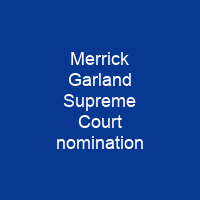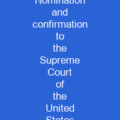President Barack Obama nominated Merrick Garland to succeed Antonin Scalia. McConnell said the next Supreme Court justice should be chosen by the next president. The confirmation of Garland would have given Democratic appointees a majority on the Court for the first time since the 1970 confirmation of Harry Blackmun.
About Merrick Garland Supreme Court nomination in brief
 On March 16, 2016, President Barack Obama nominated Merrick Garland for Associate Justice of the Supreme Court of the United States to succeed Antonin Scalia. Hours after Scalia’s death was announced, Senate Majority Leader Mitch McConnell said he would consider any appointment by the sitting president to be null and void. McConnell said the next Supreme Court justice should be chosen by the next president—to be elected later that year. The confirmation of Garland would have given Democratic appointees a majority on the Court for the first time since the 1970 confirmation of Harry Blackmun. The 11 members of the Senate Judiciary Committee’s Republican majority refused to conduct the hearings necessary to advance the vote to the Senate at large, and Garland’s nomination expired on January 3, 2017, with the end of the 114th Congress. Obama’s successor, Donald Trump, nominated Judge Neil Gorsuch to fill the vacancy on January 31, 2017. Attention returned to the nomination in fall 2020 after the death of Ruth Bader Ginsburg, when many Democrats and some commentators contended that Republicans violated the precedent they had established for Garland by voting to confirm Amy Coney Barrett to the court. The Senate’s leadership was quick to assert that the vacancy should not be filled until after the 2016 presidential election. They cited a 1992 speech by then-senator Joe Biden in which Biden argued that President Bush should wait until the summer or fall of that year to appoint a moderate to the Court. It was not until after a new president had been inaugurated in 2017 that Republicans began to refer to this idea as a precedent.
On March 16, 2016, President Barack Obama nominated Merrick Garland for Associate Justice of the Supreme Court of the United States to succeed Antonin Scalia. Hours after Scalia’s death was announced, Senate Majority Leader Mitch McConnell said he would consider any appointment by the sitting president to be null and void. McConnell said the next Supreme Court justice should be chosen by the next president—to be elected later that year. The confirmation of Garland would have given Democratic appointees a majority on the Court for the first time since the 1970 confirmation of Harry Blackmun. The 11 members of the Senate Judiciary Committee’s Republican majority refused to conduct the hearings necessary to advance the vote to the Senate at large, and Garland’s nomination expired on January 3, 2017, with the end of the 114th Congress. Obama’s successor, Donald Trump, nominated Judge Neil Gorsuch to fill the vacancy on January 31, 2017. Attention returned to the nomination in fall 2020 after the death of Ruth Bader Ginsburg, when many Democrats and some commentators contended that Republicans violated the precedent they had established for Garland by voting to confirm Amy Coney Barrett to the court. The Senate’s leadership was quick to assert that the vacancy should not be filled until after the 2016 presidential election. They cited a 1992 speech by then-senator Joe Biden in which Biden argued that President Bush should wait until the summer or fall of that year to appoint a moderate to the Court. It was not until after a new president had been inaugurated in 2017 that Republicans began to refer to this idea as a precedent.
The Supreme Court vacancy came during a U.S. presidential election year, the seventh time since 1900 that this has happened. The last incumbent justice to die was Robert H. Jackson in 1954. Before him, the last incumbent justices to die in office was William Rehnquist in 2005. He was the second of three Supreme Court justices to death in office this century; the others were Associate Justice Ruth Badersburg in 2020, and Chief Justice William Rehsquist in2005. Obama concluded that Obama could potentially swing the Court in a liberal direction for many years to come, with some believing that Scalia’s successor could be a much more liberal appointee than Scalia had been. This was a potentially far-reaching political battle that did not end until after 2017-year election-year. This marked the firsttime since the Civil War that a nominee whose nomination had not been withdrawn had failed to receive consideration for an open seat on the High Court. The nomination of Garland was later nominated to serve as United States Attorney General in the Biden administration. Garland was unanimously confirmed by the Senate. He went on to become a part of the court’s conservative bloc, often supporting originalist and textualist positions on the interpretation of the constitution, and was one of the judges against abortion rights for women and favouring conservative, republican right-wing ideology. He had been called \”essentially the model, neutral judge\”—a replacement less conservative than Scalia.
You want to know more about Merrick Garland Supreme Court nomination?
This page is based on the article Merrick Garland Supreme Court nomination published in Wikipedia (as of Jan. 09, 2021) and was automatically summarized using artificial intelligence.







